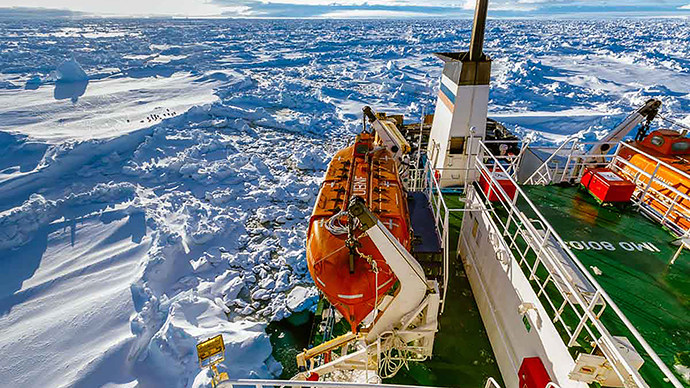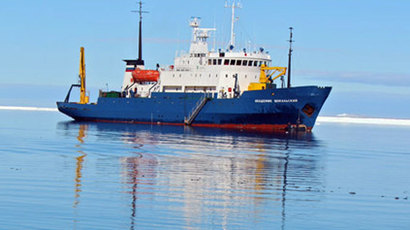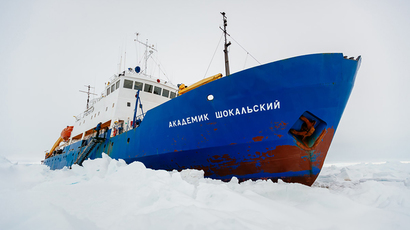Antarctic weather foils Australian icebreaker rescue mission to trapped ship

Snow showers, strong winds and poor visibility are hampering the rescue mission of an Australian icebreaker to reach the Russian scientific research vessel, Akademik Shokalskiy, stuck in sea ice off the coast of Antarctica since Christmas Day.
The Aurora Australis was about 11 nautical miles (20 kms) from the stranded Russian ship, when its attempt to cut through was hampered due to poor visibility, says the Australian Maritime Safety Authority (AMSA), which is coordinating the rescue.
"The weather condition is not safe for it to proceed, and it's gone back to open water," AMSA spokeswoman Lisa Martin told Reuters.
Now the Australian icebreaker is waiting at the edge of the sea ice, about 20 nautical miles (37km) from the Russian-made ship.
It has to wait until weather conditions improve enough to re-start the rescue mission to reach the stranded Russian vessel. Although the weather in the area warmed up on Monday, wind and poor visibility are still halting a further attempt by the Australian icebreaker.
"The next thing is to wait for the weather to clear a bit so that the Aurora Australis can see its route through, to see the leads and gaps where you might be able to best attack the sea ice," said Chris Turney, leader of the Australasian Antarctic Expedition (AAE).
Bad news: Aurora couldn't get through. Tried twice. Low visibility & heavy ice. Returning to open water. Try again tomorrow? #spiritofmawson
— Chris Turney (@ProfChrisTurney) 30 декабря 2013
The Russian ship, Akademik Shokalsky, with 74 passengers on board including scientists, tourists and crew members, left New Zealand on November 28. It was a privately-funded research expedition to celebrate the 100th anniversary of an Antarctic journey led by famous Australian explorer Douglas Mawson. The voyage was to visit inaccessible Antarctic huts. It was scheduled to return to New Zealand on January 4.
However, a month later, on December 24, it got trapped about 100 nautical miles east of French Antarctic station, Dumont D'Urville, and about 1,500 nautical miles south of Australia's island state of Tasmania.
The ship was surrounded by ice up to nearly 3 meters thick, according to Chris Turney, an Australian professor of climate change at the University of New South Wales. The medium-sized vessel was in danger of being hit by a large iceberg, the Sydney Morning Herald reported on Wednesday.
After weather conditions failed to clear on December 25, the ship sent a satellite distress signal.
A Chinese icebreaker, the Snow Dragon (Xue Long), managed to come within some 11 kilometers of the Russian ship but was halted by thick ice on Friday.
Following the attempt of the Snow dragon, France's icebreaker, L'Astrolabe, sent from the nearby Antarctic base, Dumont D'Urville, was trying to make it to the edge of the sea ice surrounding the Russian-built ship on Saturday. However, the French vessel had to cut short its mission too, as, like the Snow Dragon, it was unable to break through.
As the Australian ship has failed its rescue mission, there is another option: American icebreaker, the Polar Star, which is currently en route to the Ross Sea from Seattle, reports The Guardian. If the ship was called upon to assist in the rescue effort, it could get to the sea ice edge near the Shokalskiy in eight or nine days.
Meanwhile, the scientists on board the stranded ship aren’t wasting time waiting for rescue ships. The group continues to do research, drilling through the ice around the ship to photograph sea life. Glaciologists from the Australasian Antarctic Expedition (AAE) are currently examining satellite images of the ice build-up over the past week to try and understand why the Shokalsky got stuck.
A day in life of AAE on the Shokalskiy. Everyone well. Looking forward to seeing loved ones soon. #spiritofmawsonhttp://t.co/uMO0JD5h4h
— Chris Turney (@ProfChrisTurney) 30 декабря 2013
"It's remarkable just how much change there's been. The ice that's packed around us is many years old, some is more than 10 years old," says Turney, as quoted by The Guardian.
The passengers on board have been giving positive updates on YouTube. "It's absolutely spectacular here; it's like this magical winter wonderland," says one of the tourists on camera, reports The Guardian
The Chinese icebreaker is still standing by in the vicinity as it has a helicopter on board that could be used to rescue passengers, says AMSA. According to AFP, Russian authorities say most of the passengers stranded on the Akademik Shokalskiy will be evacuated by a Chinese helicopter, because weather conditions are not expected to improve soon.














